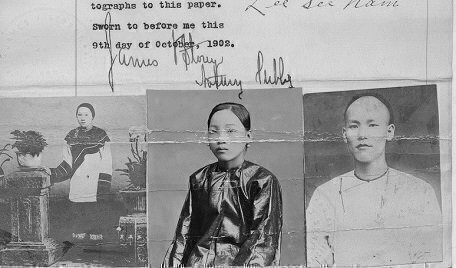The debate over immigration restrictions in the United States isn’t a new topic. A quick review of American immigration policies shows that legal cases over restrictions date back to the 1880s, and various groups have been barred entry to the United States since then.

The current debate is centered on the Trump administration’s policy, enacted with an executive order, that temporarily restricts immigration for refugees to the United States and for residents of seven Middle Eastern countries seeking valid visas.
President Trump cites powers granted to him by Congress under the Immigration and Naturalization Act of 1952 as allowing the President to place temporary restrictions on immigration based on country of origin. Opponents of the policy object to the executive order on various constitutional grounds, including claims the President’s executive order violates the separation of powers provisions in the Constitution and poses a religious test for entry into the country.
In the past, tests and criteria have been frequent factors in considering admission to this country. And adherents to some political and moral philosophies have consistently been barred from entry to America.
Today, the federal government has the authority to decide who becomes a citizen or resides in the United States. Congress set the first basic immigration requirement in 1790, which required a two-year residency in the United States for those who sought citizenship.
Congress and the executive branch work together on matters of immigration policy and enforcement. Although there is no explicit mention of immigration policy in the Constitution, a series of Supreme Court decisions has established that the political branches of the federal government—Congress and the President—share responsibility for immigration. In many cases, Congress passes immigration laws enforced by the executive branch; in other cases, the executive branch has prosecutorial discretion to implement immigration policies.
In 1875, the first direct immigration-criteria law, the Page Act, came from Congress. It declared that people and groups could be excluded as immigrants based on specific criteria. Initially, prostitutes and criminals were banned from entry, and port inspectors were appointed to question and screen immigration candidates.
The Chinese Exclusion Acts, passed by Congress and signed into law by President Chester Alan Arthur in 1882, at first barred Chinese laborers from entering the United States, and these restrictions were expanded to many ethnic Chinese, regardless of nationality, in subsequent laws.
The Supreme Court ruled on the constitutionality of the Chinese Exclusion Acts in 1889 in the case of Chae Chan Ping v. United States, where the Court said that immigration matters were part of the plenary power shared by the legislative and executive branches and disputes over those laws “are not questions for judicial determination.”
The Immigration Act of 1891 expanded the list of "undesirables" to include “idiots, insane persons, paupers or persons likely to become a public charge,” persons suffering from certain contagious disease, felons, persons convicted of other crimes or misdemeanors related to “moral turpitude,” and polygamists. In 1903, an immigration act signed by President Theodore Roosevelt added anarchists to the banned list and the act allowed immigration officials to ask people about their political beliefs during the questioning process.
In 1917, another act combined all the previously defined excluded groups in one do-not-admit list; added alcoholics to the list; required literacy tests; and banned people from many parts of the Asia-Pacific region, and in 1924, quotas were set for immigration based on countries of origin, and Japan was effectively added to the do-not-admit list.
By the 1950s, immigration exclusion laws changed to lift the ban on Chinese immigration, and the 1952 McCarran-Walter Act (also known as the Immigration and Naturalization Act) eliminated immigrants who advocated “the economic, international, and governmental doctrines of world communism.” (President Harry Truman vetoed the McCarran-Walter Act, but Congress overrode the veto.)
The 1952 version of the Immigration and Naturalization Act combined various immigration laws and provisions into one act. The act has been amended many times since then, including a significant revision in 1965.
As the immigration system has grown more complex, there are still some basic criteria left from older exclusion laws.
In overall terms, the Immigration and Naturalization Act provides for an annual worldwide limit of 675,000 permanent immigrants, with exceptions for close family members. Potential immigrants are evaluated based on family, employment, refugee and country-of-origin criteria.
According to the State Department rules on which criteria make potential immigrants ineligible for visas under the INA, people can be excluded if they have certain health conditions or have a criminal record. Potential immigrants found to have terrorist ties are also excluded, including anyone who “endorses or espouses terrorist activity or persuades others to endorse or espouse terrorist activity or support a terrorist organization.”
Anyone who is a current member of a totalitarian party is still excluded, such as “any immigrant who is or has been a member of or affiliated with the Communist or any other totalitarian party (or subdivision or affiliate thereof), domestic or foreign.” There are provisions to allow former party members to come to the United States as immigrants, based on how long ago they ceased their party membership and if they lived in a nation where the ruling government prescribed party membership. And the ban placed on polygamists back in 1891 still stands.
Scott Bomboy is editor in chief of the National Constitution Center.







